Catocala subnata
Catocala subnata
kah-TOCK-uh-lahmsub-NAY-tuh
Grote, 1864
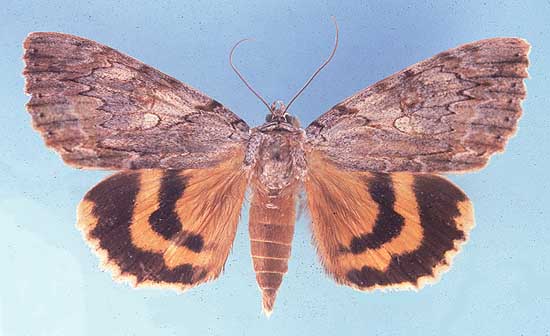
The Youthful Underwing, courtesy of James K. Adams.
This site has been created by
Bill Oehlke at oehlkew@islandtelecom.com
Comments, suggestions and/or additional information are welcomed by Bill.
| TAXONOMY:
Superfamily: Noctuoidea
Family: Noctuidae
Group: Noctuinina
Subfamily: Catocalinae
Genus: Catocala, Schrank, 1802
| |
MIDI MUSIC
"Moon River"
copyright C. Odenkirk
MIDI CITYON.OFF
<bgsound src="moon.mid" LOOP=FOREVER>
|
DISTRIBUTION:
It has also been reported in
Arkansas,
Georgia,
Illinois,
Indiana,
Kansas,
Maryland,
Massachusetts,
Minnesota,
Mississippi,
Missouri,
Nebraska,
New Hampshire,
New Jersey,
New York,
Ohio,
Pennsylvania,
South Carolina,
Vermont,
Virginia and
West Virginia.
The forewings are greyish white with blue-grey and light brown scales.
Catocala subnata, Peterborough, Ontario, August 2, 2006, courtesy
of Tim Dyson. | 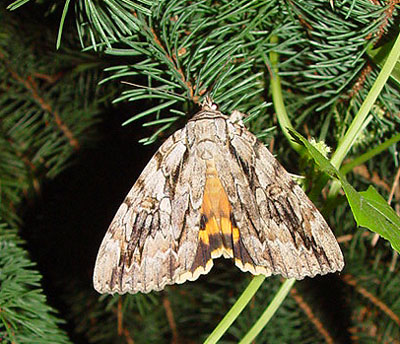 |
Catocala subnata usually have hindwings that are a brighter
yellow than those of neogama. Neogama usually have a
basal dash absent in male subnata, but present in females.
Magnification of hind tibia helps to distinguish the two
species:
subnata: cylindrical hind tibia
neogama: compressed or flattened hind tibia
subnata: ventral surface of tibia densely covered with evenly
distributed spines.
neogama: ventral surface of tibia sparsely covered with
sporadic spines.
Tim's image of this specimen, feeding on a rotting apple, clearly
shows the dense covering of spines.
| 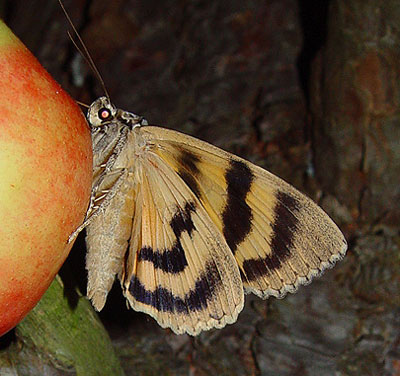 |
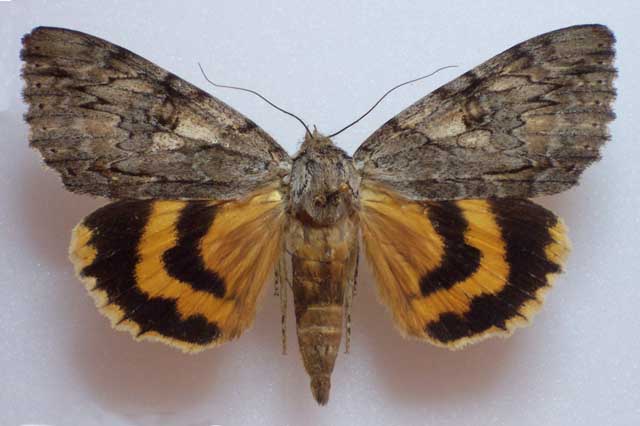
Catocala subnata, bait trail, Mason, Ingham County, Michigan,
September 1, 1996, courtesy of Harry King.
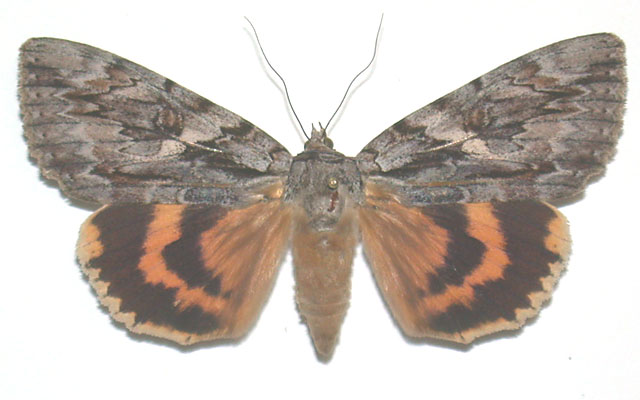
Catocala subnata female, courtesy of Pierre Legault.
My first impression of the above specimen was that
of C. neogama, probably due to the heavier markings
and basal dash, but C. subnata females have the
basal dash and generally are more strongly marked than males.
Also note the uniformly pale, elongated and open subreniform spot
which is characteristic of subnata.
The abdomen is bright ochre yellow, in strong contrast to
the grey thorax.
Pierre Legault assures me the above specimen in C. subnata
based on examination of tibia.
Tim Dyson image, right, also displays those same characters.
| 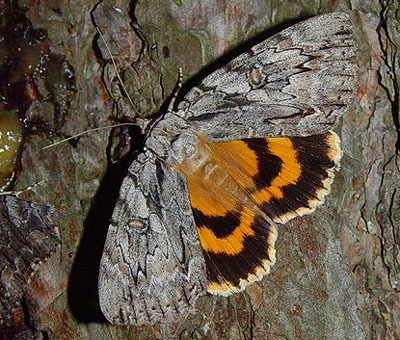 |
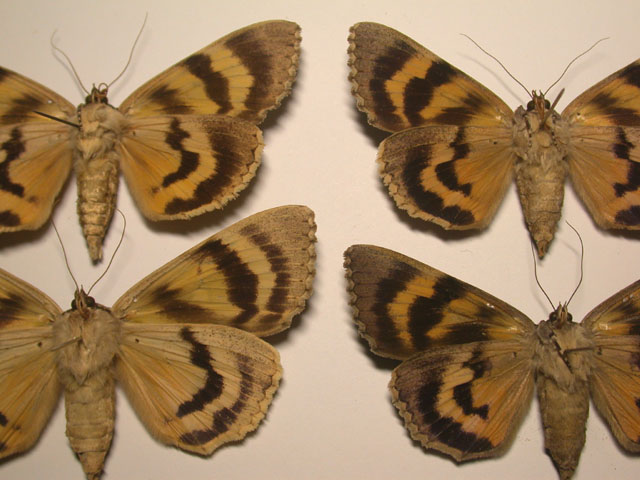
Catocala subnata, male and female left, courtesy of Pierre Legault;
Catocala neogama, females right, Montreal, Quebec, August 2002
Note the general overall darker appearance of C. neogama as well
as the slightly smaller size and the termination of the hindwing
median band.
Visit C. neogama / C. subnata / C. piatrix comparison.
FLIGHT TIMES AND PREFERRED FOOD PLANTS:
Catocala subnata flies as a single
generation with moths on the wing from July to September.
Moths come in to lights readily and also to bait.
The Catocala subnata caterpillar show a preference for
black walnut, butternut and hickory.
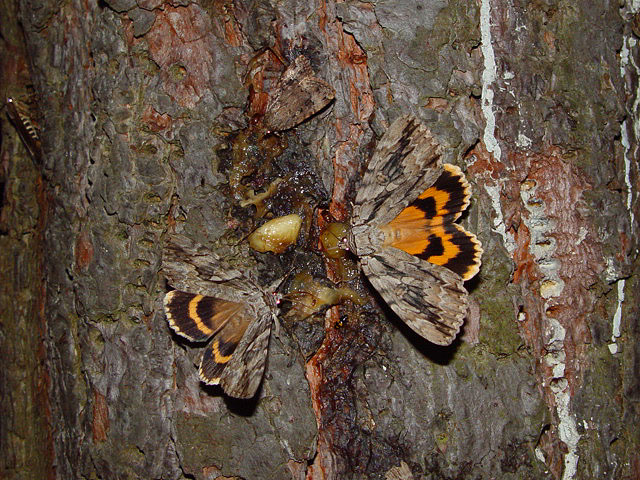
Catocala cerogama and Catocala subnata at bait, August 2, 2006,
Peterborough, Ontrio, courtesy of Tim Dyson.
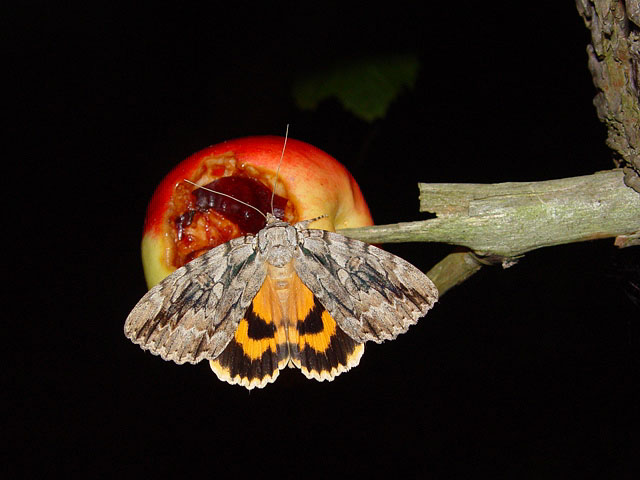
Catocala subnata at "apple on a stick", August 2, 2006,
Peterborough, Ontrio, courtesy of Tim Dyson.
ECLOSION:
Adults eclose from pupae formed under leaf litter.
SCENTING AND MATING:
Catocala subnata females
emit an airbourne pheromone and males use their antennae to track the
scent plume.
EGGS, CATERPILLARS, COCOONS AND PUPAE:
Eggs are deposited on bush bark in the fall and hatch the
following spring. The Catocala subnata caterpillar show a preference for
black walnut, butternut and hickory.
|
|
Larval Food Plants
Listed below are primary food plant(s) and alternate food plants.
It is hoped that this alphabetical listing followed by the common
name of the foodplant will prove useful. The list is not exhaustive,
although some species seem very host specific.
Experimenting with closely related foodplants is worthwhile.
Carya cordiformis.....
Juglans cinerea
Juglans nigra
|
Bitternut hickory
Butternut
Black walnut
|
Use your browser "Back button to return to the previous page.
Goto Main Catocala Index
This page is brought to you by Bill Oehlke and the
WLSS. Pages are on space rented from Bizland. If you would like to become a "Patron of the Sphingidae/Catocala Sites",
contact Bill.
Please send sightings/images to Bill. I will do my best to respond to requests for identification help.
Enjoy one of nature's wonderments: Live Saturniidae (Giant Silkmoth) cocoons.

|

To show appreciation for this site, click on the flashing
butterfly to the left, a link to many worldwide insect sites. |
Visit Harry King, Michigan Catocala Collection.
Visit Tom Payne, Tennessee Catocala collection.










